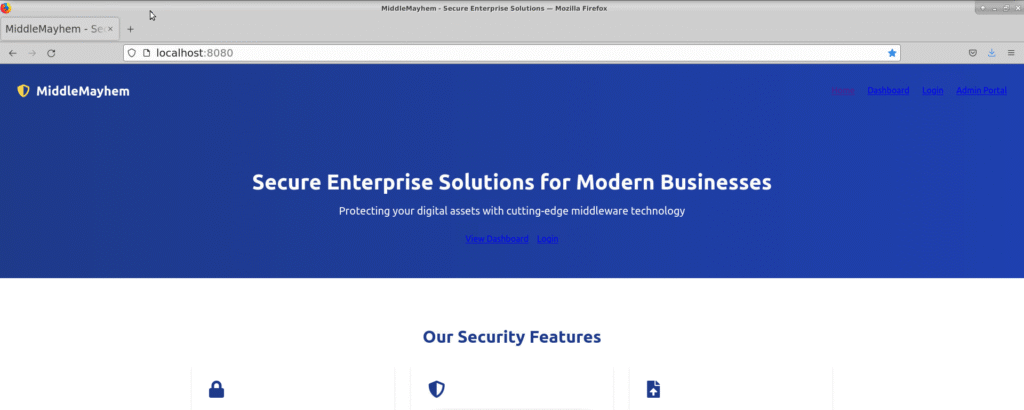John works in the security team at MiddleMayhem Incorporated. The security team detected unusual network traffic to their admin portal. However, no security breaches have been confirmed. John got SIEM logs about the incident from his team. He has to analyze the attack pattern to determine how the attackers bypassed authentication, achieved remote code execution, and moved laterally across the network.
Lab Information
| Difficulty | Easy |
| OS | Linux |
| Points | 25 |
| Created By | BTLO |
MiddleMayhem Website
The Middlemayhem company’s website is already being bookmarked. Now, let’s go check the website.

- Framework Information
If we examine the footer, we can see that the website uses the JavaScript Framework Next.js, 15.0.0.

- Finding Sensitive (Juicy) URL
While looking through the homepage, we can see multiple URLs in the footer bar of the MiddleMayhem website.

There are three links down there: Sitemaps, Admin, and Robots.
- The Sitemap is giving a 404 error, which is not what we are looking for.
- Admin gives you a login portal, which may be helpful for hackers. This is one of the juicy links. This link goes to /login.
- Only the Robots page is left. While looking for juicy URLs, we found two exciting ones: /admin and /admin/file-upload.

We now have a problem: we need two URLs, but we have three: /login, /admin, and /admin/file-upload.
There’s a funny catch /admin redirects to /login.
The two URLs should be /login and /admin/file-upload.
Splunk
Now, we will check the logs through the Splunk SIEM. In the image below, we can see numerous logs.

- Checking malicious IP Address
Let’s see the IP address from which the connections are made. For that, we have to check the source IP from the side filters.

From 172.217.164.174 and 218.92.0.204, a large number of connections have been established.
We will check both IP Addresses one by one.
The 172.217.164.174 IP address looks clean.

Now, it’s time to check the 218.92.0.204 IP Address.

Here, as we can see, the attacker attempted to upload a Bash shell script named “shell.sh”. This IP is malicious to the company. The 218.92.0.204is the attacker’s IP address.
- Checking the number of unique Uniform Resource Identifier (URI)
host=webapp ip_src=218.92.0.204 | stats dc(http_request_uri)
The total number of unique URI, we got is 9930.
- HTTP Header
First, we need to read some articles to find some clues. In one of the articles, there’s something mentioned about middleware, just like below the image.

Now, we will search in Splunk.
We search middleware as a query and we got 7 search results.
Upon reviewing the search results, the first one contains a header mentioned as x-middleware-subrequest.
- Attacker access after exploiting the CVE
For this, we need to focus on the search results within the header “middleware”.
We will use the filter http_request_uri. There are two URIs available: /admin and /api/upload.

/api/upload is the URI which we are looking for.
- Finding reverse shell
host=webapp shellIn the first search result, there’s information about the shell and the NC details of IP and Port number.

IP address: 113.89.232.157 and port number: 31337
- Lateral movement
As we know, the MiddleMayhem website has a login portal, which means employees may have login credentials.
We were looking for a password in the search results. We found the host database server (dbserver) using the SSH login method.

In lateral movement, an attacker can perform actions such as SSH, bruteforce, RDP, PtT, PtH, and so on.
The attacker doesn’t have the hash or login credentials. So, PtT, PtH and RDP are eliminated. So, two left: SSH and bruteforce.
It will likely be an SSH bruteforce attack, as they may not have credentials for SSH login.
- Identify the user account
While looking for lateral movement, we can see the user account name in the same result as below.

The user account is dbserv.
Looking For CVE
Now, as we have the information about the framework, Next JS. We will utilise one of the most effective OSINT tools, Google.

While looking, we got the CVE-2025-29927.
Conclusion
MiddleMayhem is more than a simple lab. It’s a tutorial on modern web exploitation, log analysis, and real-time detection. It’s crucial to understand how even a minor header can lead to a breach in today’s rapidly evolving threat landscape.
MiddleMayhem lab will teach you to think like a defender — quick, analytical, and constantly adapting — regardless of your level of experience as a blue teamer or as a novice SOC analyst.


